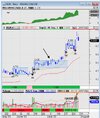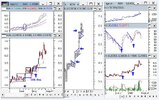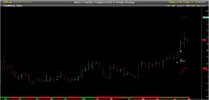- Joined
- 30 June 2007
- Posts
- 7,200
- Reactions
- 1,226
Thanks.Buying and Selling Pressure Indicator
The Buying and Selling Pressure Indicator (developed by another) has invoked a lot of interest which is actually a very simple indicator using the excursion of the price.
Many times it is just a matter of how we are looking at the data
We can glean a lot of information if we look at the data the right way. The buying and selling pressure indicator is also the same case. It's a very simple Indicator, using the Open, High, Low, and Close and the Volume. It obviously not a Holy Grail, but does give a very good picture of the buying and selling pressure.
The "raw buying and selling indication"
Is provided in terms of a Histogram. Green bars above zero show the buying pressure and the red bars below the zero line show the selling pressure. This presents a good visual representation of the dominating pressure.
The second is a "smoothed version"
This version with a yellow line representing the selling pressure and a turquoise line which represents the buying pressure. If the turquoise line is above the yellow line it would mean that the buying pressure is more and vice versa. The difference between the two is plotted as a Histogram. This is a cumulative value of the buying and selling pressure and provides an easy visual presentation of the dominating pressure.
The trifecta
The two indicators the (Raw and Smoothed Buying Pressure Indicator) and the (Percentage Up Filter) can easily complement any trading strategy.
View attachment 160265
Skate,
It's a very simple Indicator, using the Open, High, Low, and Close and the Volume
How does it use volume when indices like XAO don't have volume?







